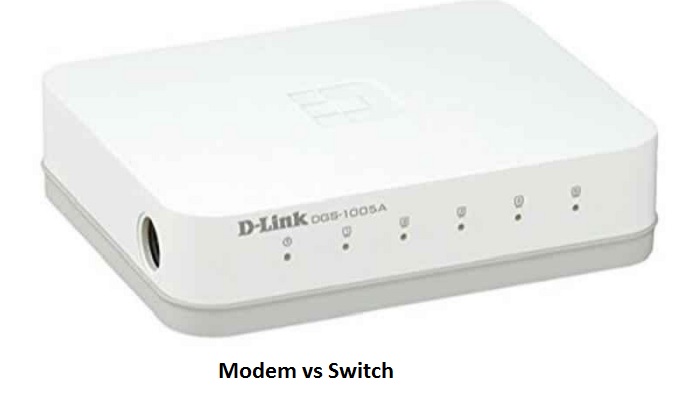It is quite challenging for a first timer or one who is not very tech savvy to understand computer networking fully given the fact that it is full of technical terminology.
Add to that, the different devices used in it, such as a modem and a switch that appears to be similar, may make things all the more difficult.
Well, similar as they seem to be, a modem and switch perform significantly different functions.
Here is an article that will guide you through the concept of a modem and a switch used in computer networking so that you understand the roles of the two seamlessly.
With the differences between them cleared, it will be easy for you to know which is more useful.
In This Article
KEY TAKEAWAYS
- A modem and a switch look similar in appearance but play different roles in a computer network.
- A modem is a hardware device and is a short for a modulator-demodulator. It primarily helps you to connect your system to the internet.
- The switches, on the other hand, simply connect the systems within a particular network and are responsible for the transfer of both incoming and outgoing internet traffic between the interconnected devices.
The 5 Differences Between Modem and Switch

1. Basic Difference
The modems are typically like routers that help you to connect your computer system to the internet as well as different network segments.
On the other hand, the switches cannot connect several networks. These are also not able to share an internet connection.
2. Sophistication Level
The modems are considered to be highly sophisticated and have a relatively complicated working process in comparison to a switch.
They send signals only after converting them to the desired formats.
On the other hand, the switches of a network are reasonably sophisticated when they are compared with the modems.
The switches simply direct the data and traffic from one point to another without any further manipulations made in it.
3. Working Process
The modem typically works at Physical or Layer one of the OSI or Open Systems Interconnection models which usually deals with the MAC or Media Access Control addresses.
On the other hand, the switches of a network typically use the MAC address of a device directly for sending the data only to that particular port to which the destination device is plugged in.
The switches work at the Data Link or Layer 2 of the OSI model.
4. Function
A modem stands for a modulator-demodulator. The function of a modem is to facilitate the transfer of data by coding and decoding analog and digital signals as necessary.
A switch of a network, on the other hand, performs the basic function of connecting the different segments or computers together on one Local Area Network or LAN which makes it quite different from the modem and even a router.
5. Purpose
The modem converts the analog signals received from the telephone lines into digital signals for the computer to identify and comprehend easily.
On the other hand, it also alters the digital signals received from the computer into analog signals for the telephones lines to carry them.
The switch, on the other hand, helps in sending the data to the particular device that requests it or needs it.
A switch is typically used in order to enhance the performance and capacity of a network.
Which is More Useful – Modem or Switch?

In the world of computer networking, typically, both modem and switches are ubiquitous pieces of equipment.
Both of them are quite useful today and you will find them being used in almost everywhere from the data centers to households.
The modem can be considered as the information collection center from the Wide Area Network or WAN since it connects directly to the outside world.
A modem is an essential device required when you want to connect your computer to the internet.
A modem is located in between the computer and the telephone line establishing a connection between the two.
The modem, which is however provided by the ISP or Internet Service Provider, is also a device that helps in connecting the network to the ISP.
When a modem is used in isolation, which means without any switch or a router, it can be used to connect only one single computer with the help of an Ethernet port.
On the other hand, the switch typically connects two or more nodes of a network in the same network or in a different network to direct the data to the right destination by using the MAC addresses.
The switch of a network can also be used to connect different types of network devices apart from a computer such as a printer and others to a Home LAN.
If you want to understand a modem and a switch and their differences in operations in a much better way it is better to have a bit of knowledge about the Open Systems Interconnection or OSI reference model.
This refers to the framework developed by the ISO or International Organization of Standardization in 1984 with an intention to oversee and control the way information and data is communicated via a computer network.
Since both modems and switches are network devices, they fall under the peripheries of the OSI reference model.
In the OSI reference model there are typically seven different layers, each with a different name and designated to carry different types of data. These are:
- Layer 1 or Physical Layer that supports bits and symbols
- Layer 2 or Data Link Layer that supports frames
- Layer 3 or Network Layer that supports packets
- Layer 4 or Transport Layer that supports segments and datagram
- Layer 5 or Session Layer that supports data
- Layer 6 or Presentation Layer that also supports data just like
- Layer 7 or Application Layer.
Every network device relates to one of these layers of the OSI reference model and so do the modems and the switches.
The modems are necessary to use because different types of modems can send and receive data which is irrespective of the physical connections. This is not possible by the switches.
For example:
- If you use a DSL or Digital Subscriber Line modem, it will be able to transmit data through a standard copper telephone line.
- If you use a cable modem, it will be able to transmit data through a coax cable line.
- If you use a fiber modem, it will be able to transmit data through a fiber optic fiber line.
- And, if you use a satellite modem, it will be able to transfer data through a satellite connection.
Well, the point is that depending on the type of the modem used, you can transfer data through a varied type of physical connections.
However, it will use a particular set of protocols or communications standards that it is specifically built to support.
So, after all these explanations regarding the OSI reference model and different types of modems, it is clear that the modem is a Layer 1 device.
It transfers data in bits, which is the fundamental form of data and is basically denoted in 0s and 1s only.
On the other hand, switches create and route between several TCP/IP or Transmission Control Protocol/Internet Protocol networks.
However, as said earlier, a switch can only help in communications between the devices within the same network.
Now, considering all these facts and factors, the switches can be considered as the Layer 2 device.
This is because the switches simply help the frames to move forward in a network.
However, the modern switches are so designed that it is not confined to any particular layer of the OSI reference model.
In fact, they now fall into all the layers of this model having additional functionalities such as:
- Routing
- Cookie Switching
- Web switching and more.
However, if you want to make the most out of your network and use both these networking devices together, be careful about their placements.
This is important because putting the switch right after the modem is as good as not using it.
This will be a waste of the cables and some of the hardware.
Conclusion
So, after reading this article you surely have the basic concept about the modems and switches used in a computer network.
This also must have cleared all your confusions regarding these two networking devices to help you make the right choice among them and use either one or both of them.